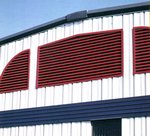Why Louvers?

Over the last several years, the use of metal construction in new buildings has grown steadily. And, like all buildings, metal structures require an adequate amount of fresh air for
HVAC and general ventilation needs. The best way to provide fresh air through a wall is with a louver. Although some still consider louvers to be an unattractive necessity that creates weather-related problems in their buildings, most designers today realize that there are a variety of louver designs and options that increase weather resistance, and make them a pleasing and necessary component in the aesthetic enhancement of any metal building.
Although some louvers are used for aesthetic purposes only - these would have "blank-offs", or insulated sheets behind them, most are used for both beauty and functional outside air intakes.
There are three important functions for louvers designed for outside air intakes installed in metal buildings: airflow capacity, weather protection and appearance. All three of these are related and must be considered when selecting and sizing louvers.
The airflow capacity of a louver is critical in many ways. Louvers must be sized to provide an adequate level of free area for the airflow desired. Too little free area raises the velocity of the airflow through the louver, which not only increases airflow resistance but can also cause rain to be pulled into the opening in intake applications. This also leads to high energy costs and excessive equipment wear. A good general rule is to keep intake airflow velocity as low as possible. The lower the intake velocity, and the greater the rating of the louver, will increase the safety factor in severe weather conditions. To ensure that louvers are sized correctly for their airflow requirement, review the louver's published performance data thoroughly and look for the
AMCA Certified Ratings Seal (
Air Management and Control Association) on the literature. The
AMCA seal is proof that an independent party has verified the performance data provided.